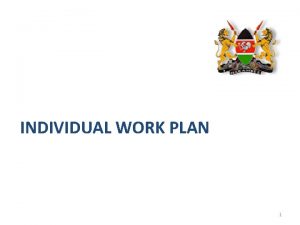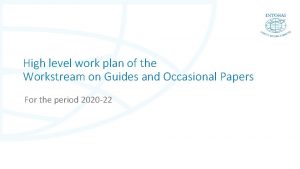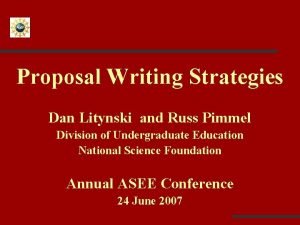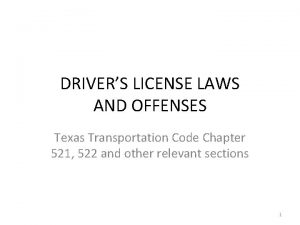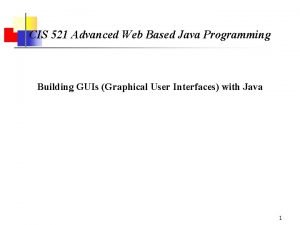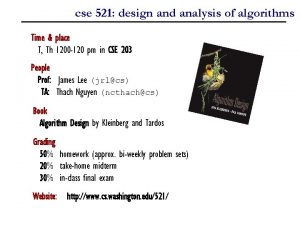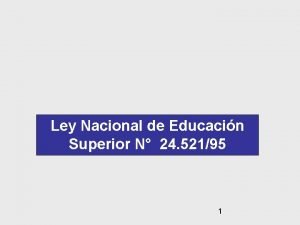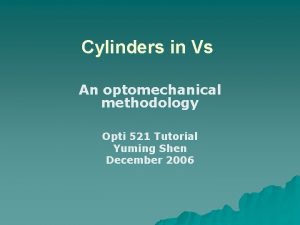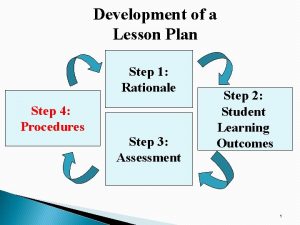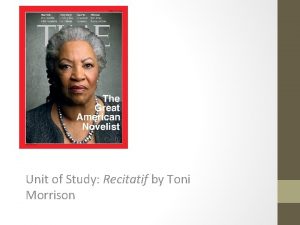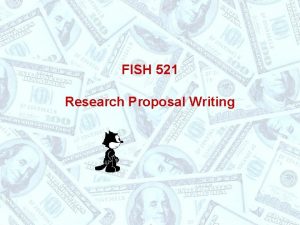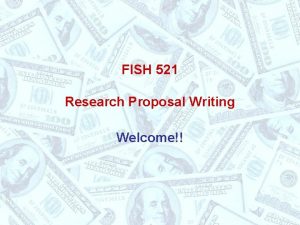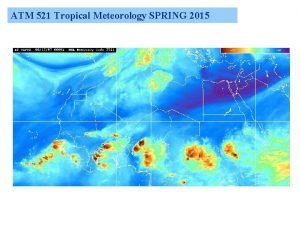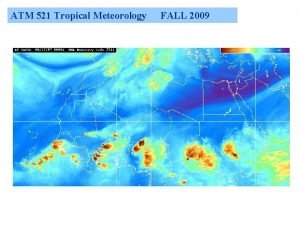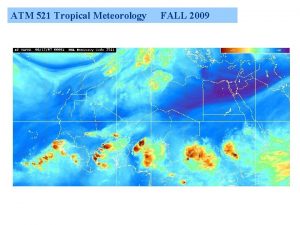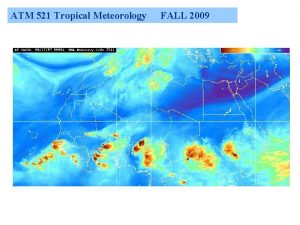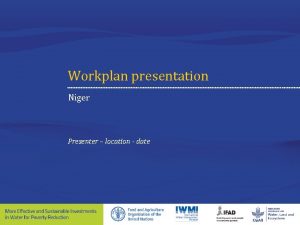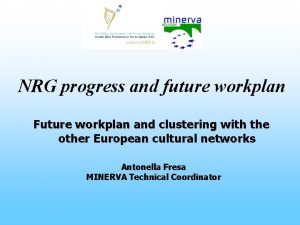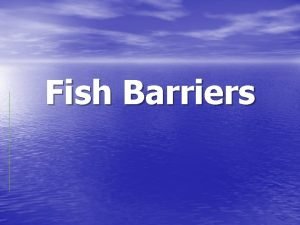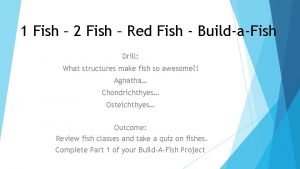FISH 521 Proposal Writing Introduction Rationale Workplan Introduction
















- Slides: 16

FISH 521 Proposal Writing Introduction & Rationale Workplan

Introduction vs Rationale Objective • • Explain significance of project (objective) Responsiveness to RFP • • Explain appropriateness of approach Provide background to methods • Current state of knowledge Content • • Broad statement of research area Brief description of what is known Identification of gaps Aims and objectives – Preliminary data, esp. your own • Review of approach – Not necessarily on study system • Description of study system – Highlight power of study system, methods and investigators • Specific hypotheses Target Audience • • Review Panel Program Manager / Director • • Reviewers Review Panel

• General structure – – General issues Introduction What is the broader issue? What is known? Where are the gaps? What can you do about it? • Link to your specific objectives • Leave details for rationale – Funnel the reader towards the aims and objectives – Focus on that aim – Highlight important points • Show graphs or tables – Summarize information – Break up text • • Include references Consider what should be in the intro – Sometimes the significance of a proposal becomes only clear in the rationale

General issues: objectives • Link between introduction and objectives – Do not introduce new concepts or issues in the objectives – Objectives should flow naturally from the introduction • Overall aim of the study – Without overall aim, it looks incoherent and piecemeal • Build objectives on issues, not methods • List 1 – Assign parentage of salmon in two creeks – Estimate reproductive success of immigrants – Estimate effective population size • List 2 – Correlate reproductive success with habitat, phenotype and population origin – Quantify the effect of bear predation and run size on the effective number of breeders • Consider broader impact in objectives – Need to be introduced too (why important ? ) – Can be added later

General issues on rationale • Avoid going into specific methods – Leave for work plan – Unless preliminary data • Provide background – Objectives – if needed – Study system – Methods • Show that you know the state of the art

General issue on writing • Avoid redundancy – Sections, paragraphs, sentences • Be concise and specific – Delete words that mean little or nothing – Delete words that repeat the meaning of other words • E. g during that period of time, the membrane area became pink in color and shiny in appearance • Avoid nominalization and empty verbs – If you have ‘make’, ‘perform’, ‘carry out’ as a verb, check if you can use something more descriptive. • Don’t use informal colloquialisms – ‘look at’ – Contractions: don’t, isn’t etc – We will assess how a affects b • Not incorrect but awkward and informal

General issue on writing • Tense – – • Be consistent Future tense for methods Past tense for preliminary results Present tense for published stuff Link paragraphs and concepts – There should be a flow in the story • Explain concepts – Don’t assume too much, especially in the introduction

Use graphs, maps, tables • A picture says more than 100 words • Break up writing • If project logistics are complicated, provide a flow chart – Your mind map would be a good start, but usually to complicated • Show diagrams for complex methods or approaches • Most empirical studies can do with a map somewhere • Show graphs if they are instructive of a specific point, even if published – But provide references

Reviewing: 3 aspects • Big picture stuff – What is the overarching issue? – How will the project address that issue? – How will the project advance science in general? • Overall organization – Are you being guided towards a specific goal? – Is there extraneous or missing information? – Could the section be structured better? • Word tinkering – Paragraph structure – Sentence structure – Edit in Word

General submission • Add new sections to existing sections – Come up with a preliminary title – Edit previous sections • Include references • Submit Word documents to Canvas – Not Google Docs • Submit version free of comments etc • Submit as a new conversation – Comments by reviewers as replies

NSF format • Title • Project Summary • Project description (10 pages, 15 for NSF) – Introduction & background (why? ) • Significance statement in book • Aims and objectives – Rationale and scope (background) • Progress to date • Can end in hypotheses – Research management plan (how? ) • Sampling and analyses • Interpretation – Contributions to education and human resources – Intellectual Merit and Broader Impact • • • References Biographical Sketches Budget and budget justification Current and pending support Facilities, equipment and other resources

The Work Plan • Primarily targeted at reviewers • Objective – To convince the reader that objectives can be accomplished • (NB: Not to reproduce experiment) • Primary questions – Best methods to address objectives? – Methods established and cited? • Can be new, but needs explanation and preliminary data (could be in rationale) – Feasible given time and funding? – Expertise of investigators – Outcomes

Consideration • How much detail? – Not too much to lose track of objectives, but enough to allow assessment of feasibility • Sample sizes – # sample sites – # samples / site – # analyses / sample • Experimental procedures – Time & money required – Depends on ubiquity of methods • If established, just cite • If not, need description and preliminary data • Make sure your methods can address the objectives – May be useful to consider in a separate section • Expected results

Two primary structures • Research Plan I • Overview of Research Plan • Materials and Methods – – Sampling Field Methods Laboratory Procedures Data Analysis • Interpretation and Expected Results • Research Plan II • Objective 1 – Materials & Methods – Interpretation • Objective 2 – Materials & Methods – Interpretation • Objective 3 – Materials & Methods – Interpretation • Choice depends primarily on overlap in methods between objectives – II can be very effective, but tedious when repetitive

The timeline • Reality check – Things always take longer than you think they should – Be realistic • ‘Overambitious’ is one of the most damning comments • Best graphically – Provide narrative in legend

Panel exercises • Big picture stuff – What is the greatest contribution of your project for scientists • Inside your field • Outside your field – How will your project advance • The state of the science (basic science) • The state of a resource/species (applied) – Consider both theoretical and empirical contribution • Discuss you introduction & rationale – Should anything be moved, added or left out? • Identify repetitions and gaps • Funnel, focus and highlight
 One fish two fish red fish blue fish ride
One fish two fish red fish blue fish ride Twofish and blowfish
Twofish and blowfish Scale types fish
Scale types fish Individual work plan sample
Individual work plan sample National listing workplan
National listing workplan High level work plan
High level work plan Rationale sample for project proposal
Rationale sample for project proposal Rationale for project proposal example
Rationale for project proposal example Texas transportation code driving while license invalid
Texas transportation code driving while license invalid Cis 521
Cis 521 Cse 521
Cse 521 Zemax thermal analysis
Zemax thermal analysis Ley 24 521
Ley 24 521 Optisystem tutorial
Optisystem tutorial Rationale of lesson plan example
Rationale of lesson plan example Writing a rationale example
Writing a rationale example Is croaker a cartilaginous fish
Is croaker a cartilaginous fish



